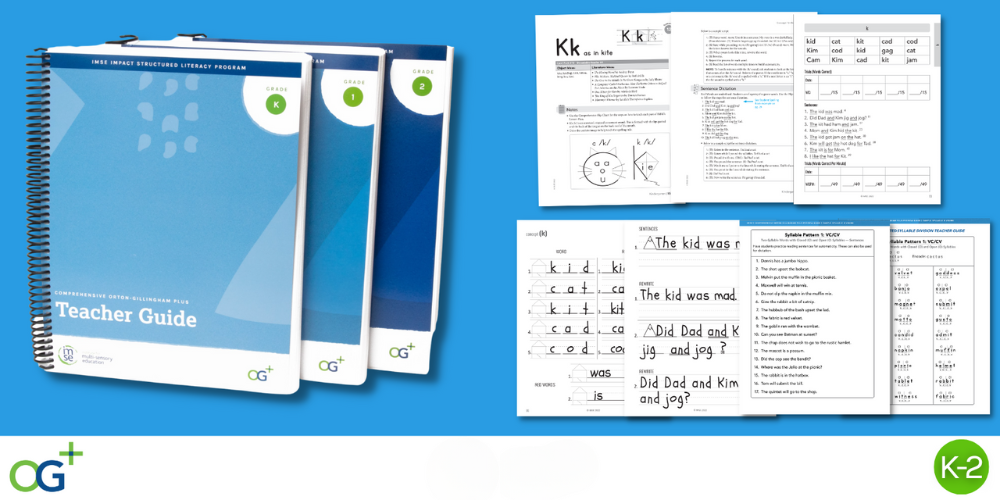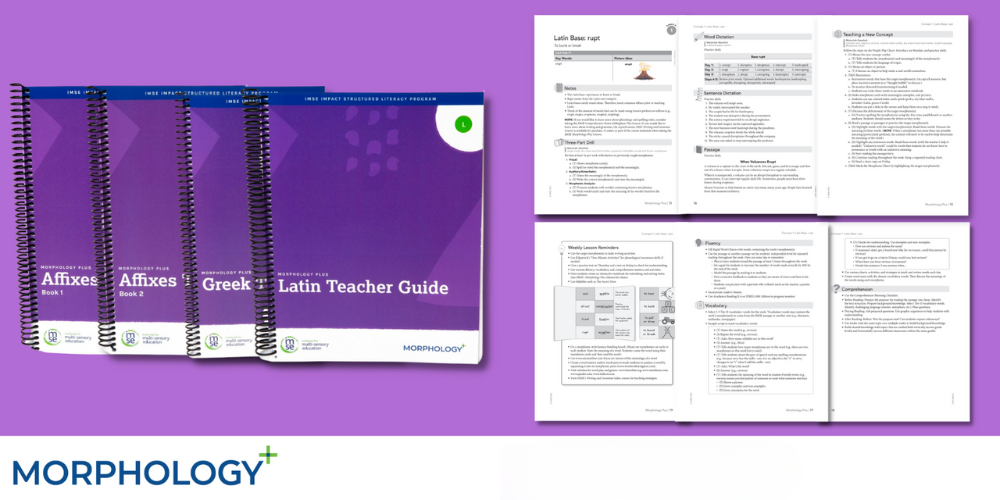We know that educators need to be empowered with knowledge and training in research-based strategies; they also need to be provided with the right tools and support to bring that newfound knowledge to the classroom.
IMSE’s Comprehensive OG+ Teacher Guides support teachers with detailed step-by-step lesson plans to guide instruction. Whether you’re supporting struggling readers or providing Tier One instruction, IMSE’s Teacher Guides are a roadmap for teaching foundational skills in literacy.

What Do IMSE Comprehensive OG+ Teacher Guides Offer?
The IMSE Teacher Guides are resources designed to support educators in effectively teaching foundational literacy skills to students. Literacy instruction encompasses various aspects of reading, writing, speaking, and listening, and these Teacher Guides are designed to provide educators with structured lesson plans, strategies, scope and sequence, and materials to help teach these skills comprehensively and systematically.
IMSE’s Teacher Guides offer a structured weekly lesson plan that incorporates all essential elements of literacy instruction throughout the week. These guides also include recommended time allocations for each specific component, covering:
- Phonological Awareness (PA)
- Cumulative Review of Previously Taught Concepts
- Explicit Instruction of Phonics Concepts And Orthography Rules
- Writing Words And Sentences (Encoding)
- Syllabication Instruction
- Teaching Irregular And High Frequency Words
- Reading Decodable Text
- Developing Language Comprehension
- Developing Written Expression
The scope and sequence for teaching foundational skills in phonics and orthography for grades K-2 are comprehensive and systematic.
In Kindergarten, students are introduced to key concepts such as:
- Consonant sounds
- Short vowel sounds
- Open vowel sounds
- Digraphs
First-grade builds upon this foundation with the inclusion of:
- Open vowel sounds with syllabication
- Consonant blends
- 1-1-1 spelling rules
- ng/nk endings
- Magic e
- Soft c and g
- Vowel teams
- Early suffixes
- Contractions
Second grade further deepens their understanding with:
- 3-letter consonant blends
- Schwa
- Bossy r’s and bossy r combinations
- Diphthongs
- The Three Great Rules
- Consonant-le
- Advanced vowel and consonant concepts
- Advanced contractions
- Silent letters
An expedited sequence is available for 3rd grade and beyond, which should be implemented after analyzing assessment results. This sequence ensures that students achieve mastery of foundational skills before progressing to morphology instruction, providing a strong foundation in literacy.

Key Components of IMSE Teacher Guides
Lesson Plans
Sample lesson plans outline the lesson’s objectives, the instructional strategies to be used, the sequence of activities, and the expected outcomes. IMSE’s lesson plans guide phonological awareness, fluency, vocabulary, and comprehension instruction.
Each plan includes a list of required materials, essential background information, recommendations for using concrete objects to enhance student understanding and a curated book list that aligns with lesson concepts and promotes oral language comprehension.
Our step-by-step instructions cover
- Three-Part Drill for cumulative review
- Teaching new concepts through multi-sensory experiences
- Addressing high-frequency “Red Words”
Teaching Strategies
These guides offer a variety of instructional strategies that teachers can use to engage students in meaningful literacy activities. These strategies include independent reading, phonics instruction, vocabulary development, and more.
The Three-Part Drill is a valuable cumulative review of previously taught concepts, promoting retention and reinforcement. When introducing new concepts, we emphasize a multi-sensory approach, fostering a deeper understanding through hands-on experiences and the practical application of words and sentences.
Our Syllable Division Teacher Guide addresses syllabication from early 1st grade through third grade, teaching four syllable patterns and six syllable types sequentially. We provide guidance on using IMSE-adopted PA materials, including decodable readers, Rapid Word Charts, and guided repeated reading to build fluency.
Scope and Sequence
Our Teacher Guides offer a scope and sequence that can be utilized in response to IMSE benchmark assessments that are included in the IMSE Training Manual. The Teacher Guide’s foreword guides teachers on where to begin instruction. The scope and sequence within these guides feature designated sections for review lessons and assessments.
Differentiation
Every classroom is unique, and IMSE recognizes that. Our Teacher Guides offer suggestions for differentiating instruction to meet the needs of students with varying skill levels, including those who may be struggling, fostering inclusive learning environments. Because concepts are sequentially structured, students know expectations and learn strategies necessary to become independent, successful learners. Article Sponsored Find something for everyone in our collection of colourful, bright and stylish socks. Buy individually or in bundles to add color to your sock drawer!
Materials and Resources
Our Teacher Guides commonly include recommendations for reading materials, writing prompts, worksheets, interactive activities, and other resources that can be used in the classroom. Our Teacher Guides suggest the use of:
- Concrete objects to represent the weekly concept
- Rich literature
- Worksheets
- Interactive extension activities
- And more!
IMSE’s Teacher Guides set the standard in building literacy knowledge by creating confident teachers who feel equipped to face the everyday challenges of working with readers at all levels and capabilities. While our Teacher Guides provide structure and guidance, teachers often adapt and tailor these resources to meet the specific needs of their students and their classroom.
Don’t miss out on the opportunity to elevate your teaching and make a lasting impact in your classroom – sign up for IMSE Impact Training today!
Please connect with us on Facebook, Twitter, Instagram, LinkedIn, and Pinterest to get tips and tricks from your peers and us. Read the IMSE Journal to hear success stories from other schools and districts, and be sure to check out our digital resources for refreshers and tips.
